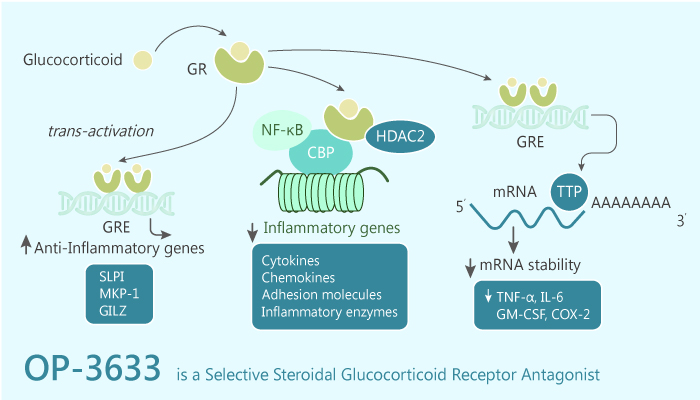Glucocorticoid Receptor (GR), also called NR3C1, is mainly for cortisol and other glucocorticoids binding. The receptor exists in nearly all the cells in the body. It regulates the development, metabolism and immune response. Once gulcocorticoids bind to GR, they mainly control gene transcription.
Since glucocorticoid receptor plays such important role in the body, dysregulation in the receptor may cause various kinds of diseases. Cushing’s syndrome, depression, diabetes, cancer, and immunosuppression may be related to the dysregulation of GR. Hence, GR antagonists may be a promising target in the treatment of these diseases.
Xiaohui Du, et al discovered a class of analogues. They synthesized them based on mifepristone, a potent steroidal GR antagonist approved by FDA. In theory, these compounds may share similar function to mifepristone. As a result, OP-3633 emerged to be a potent GR antagonist.

OP-3633 is an excellent GR antagonist. It significantly antagonizes GR with an IC50 of 29 nM. What’s more, it shows very weak antagonistic effect on androgen receptor (IC50, 912 nM) and progesterone receptor (IC50, 1135 nM), no or little agonistic effect on androgen receptor (EC50, >2500 nM).
Given the potent GR antagonistic potency, researchers evaluated in the CYP inhibition assays. However, OP-3633 poorly inhibits CYP3A4 and CYP2C8.
In vivo, OP-3633 exhibits moderate clearance and good oral bioavailability. Moreover, the antagonist is also well tolerated in female rats at a dose of 250 mg/kg/day. OP-3633 (150 mg/kg) inhibits GR target gene expression in HCC1806 xenograft tumors.
References:
1. Du X, et al. J Med Chem. 2019 Jul 25;62(14):6751-6764.